Research on Pre-Compensation and Shape-Control Optimization of Hemming Structures with Dissimilar Materials Based on Forming Process Chain
Abstract
1. Introduction
2. Shape-Control Optimization Based on Forming Process Chain
2.1. Shape-Control Modeling Method
2.2. Research Sample
3. Modeling and Experimental Validation
3.1. Roller Hemming with Adhesive
3.1.1. Modeling and Simulation
3.1.2. Experimental Verification
3.2. Curing Process under High-Temperature Cyclic Loading
3.2.1. Modeling and Simulation
3.2.2. Curing Experiment
3.3. Surface Geometry Correction and Surface Reconstruction
4. Results and Discussion
4.1. Forming Process Chain
4.1.1. Analysis of Roller Hemming
4.1.2. Analysis of Curing Process
4.2. Pre-Compensation and Shape-Control Optimization Process
5. Conclusions
Author Contributions
Funding
Data Availability Statement
Conflicts of Interest
References
- Banea, M.D.; Rosioara, M.; Carbas, R.J.C.; Da Silva, L.F.M. Multi-material adhesive joints for automotive industry. Compos. Part B Eng. 2018, 151, 71–77. [Google Scholar] [CrossRef]
- Watson, B.; Nandwani, Y.; Worswick, M.J.; Cronin, D.S. Metallic multi-material adhesive joint testing and modeling for vehicle lightweighting. Int. J. Adhes. Adhes. 2019, 95, 102421. [Google Scholar] [CrossRef]
- Tisza, M.; Czinege, I. Comparative study of the application of steels and aluminium in lightweight production of automotive parts. Int. J. Lightweight Mater. Manuf. 2018, 1, 229–238. [Google Scholar] [CrossRef]
- Fernholz, K.D. Quantifying the visibility of surface distortions in class A automotive exterior body panels. J. Manuf. Sci. Eng. Trans. ASME 2013, 135, 011001–011011. [Google Scholar] [CrossRef]
- Andersson, A. Evaluation and visualisation of surface defects on auto-body panels. J. Mater. Process. Technol. 2009, 209, 821–837. [Google Scholar] [CrossRef]
- Gürgen, S. Numerical simulation of roller hemming operation on convex edge-convex surface parts. Adv. Eng. Forum 2016, 15, 75–84. [Google Scholar] [CrossRef]
- Svensson, M.; Mattiasson, K. Three-dimensional simulation of hemming with the explicit FE-Method. J. Mater. Process. Technol. 2002, 128, 142–154. [Google Scholar] [CrossRef]
- Livatyali, H.; Larris, S.J. Experimental investigation of forming defects in flat surface-convex edge hemming: Roll, recoil and warp. J. Mater. Process. Technol. 2004, 153, 913–919. [Google Scholar] [CrossRef]
- Sigvant, M.; Mattiasson, K. FE-Simulation of hemming in the automotive industry. AIP Conf. Proc. 2005, 778, 675–680. [Google Scholar]
- Zhang, G.; Xin, W.; Jack, H. A study on fundamental mechanisms of warp and recoil in hemming. J. Eng. Mater. Technol. 2003, 123, 436–441. [Google Scholar] [CrossRef]
- Maoût, N.; Thuillier, S.; Manach, P.Y. Drawing, flanging and hemming of metallic thin sheets: A multi-step process. Mater. Des. 2010, 31, 2725–2736. [Google Scholar] [CrossRef]
- Thuillier, S.; Maoût, N.; Manach, P.Y. Numerical simulation of the roller hemming process. J. Mater. Process. Technol. 2008, 198, 226–233. [Google Scholar] [CrossRef]
- Burka, P.; Liu, X.; Thompson, M.C. Modelling of adhesive bonding for aircraft structures applying the insertion squeeze flow method. Compos. Part B 2013, 50, 247–252. [Google Scholar] [CrossRef]
- Li, J.; Zhu, W. Numerical simulation of the roller hemming process based on pressure-viscosity effect. Int. J. Adv. Manuf. Technol. 2019, 105, 1023–1039. [Google Scholar]
- Yang, Q.; Huang, P.; Fang, Y. A novel Reynolds equation of non-Newtonian fluid for lubrication simulation. Tribol. Int. 2016, 94, 458–463. [Google Scholar] [CrossRef]
- Priesnitz, K.; Sinke, J.; Benedictus, R. Influence of the temperature cycle on local distortions in car panels caused by hot curing epoxies. Int. J. Adhes. Adhes. 2014, 50, 216–222. [Google Scholar] [CrossRef]
- Vreugd, J. The Effect of Aging on Molding Compound Properties. Ph.D. Thesis, Delft University of Technology, Delft, The Netherlands, 2011. [Google Scholar]
- Fuchs, H.; Fernholz, K.D.; Deslauriers, P. Predicted and measured bond-line read-through response in composite automotive body panels subjected to elevated temperature cure. J. Adhes. 2010, 86, 982–1011. [Google Scholar] [CrossRef]
- Priesnitz, K.; Sinke, J.; Benedictus, R. On the simulation of panel distortions due to hot curing adhesives. Int. J. Solids Struct. 2014, 51, 2470–2478. [Google Scholar] [CrossRef][Green Version]
- Zhu, X.; Li, Y.; Chen, G.; Wang, P.C. Curing-induced distortion mechanism in adhesive bonding of aluminum AA6061-t6 and steels. J. Manuf. Sci. Eng. Trans. ASME 2013, 135, 051007. [Google Scholar] [CrossRef]
- Zhang, C.; Zhang, G.; Xu, J.; Shi, X.; Wang, X. Review of curing deformation control methods for carbon fiber reinforced resin composites. Polym. Compos. 2022, 43, 3350–3370. [Google Scholar] [CrossRef]
- Jansen, K.; Vreugd, J.; Ernst, L. Analytical estimate for curing-induced stress and warpage in coating layers. J. Appl. Polym. Sci. 2012, 126, 1623–1630. [Google Scholar] [CrossRef]
- Vreugd, J.; Jansen, K.M.; Ernst, L.J.; Bohm, C. Prediction of cure induced warpage of micro-electronic products. Microelectron. Reliab. 2010, 50, 910–916. [Google Scholar] [CrossRef]
- Yoon, M.; Seo, B.; Lim, C.S. Reverse compensation to prevent post-molding dimensional distortion of automobile parts manufactured using CF-SMC. Int. J. Adv. Manuf. Technol. 2022, 123, 4181–4194. [Google Scholar] [CrossRef]
- Yang, X.A.; Feng, R. A die design method for springback compensation based on displacement adjustment. Int. J. Mech. Sci. 2011, 53, 399–406. [Google Scholar] [CrossRef]
- Christian, K.; Mathias, L.; Karl, R. Springback simulation of the process chain press line forming and roller hemming processes. Key Eng. Mater. 2013, 549, 231–238. [Google Scholar]
- Li, J.; Zhu, W.; Li, Y.; Tang, G. Numerical study on curing-induced residual stress and deformation of adhesively bonded sandwich structures of dissimilar materials. Int. J. Adv. Manuf. Technol. 2022, 120, 1189–1201. [Google Scholar] [CrossRef]
- Gong, K.; Shao, S.; Liu, H.; Wang, B.; Tan, S.K. Two-phase SPH simulation of fluid-structure interactions. J. Fluids Struct. 2016, 65, 155–179. [Google Scholar] [CrossRef]
- Song, H.W.; Pan, P.F.; Ren, G.Q.; Yang, Z.H.; Dan, J.Q.; Li, J.L.; Xiao, J.F.; Xu, J.F. SPH/FEM modeling for laser-assisted machining of fused silica. Int. J. Adv. Manuf. Technol. 2020, 106, 2049–2064. [Google Scholar] [CrossRef]
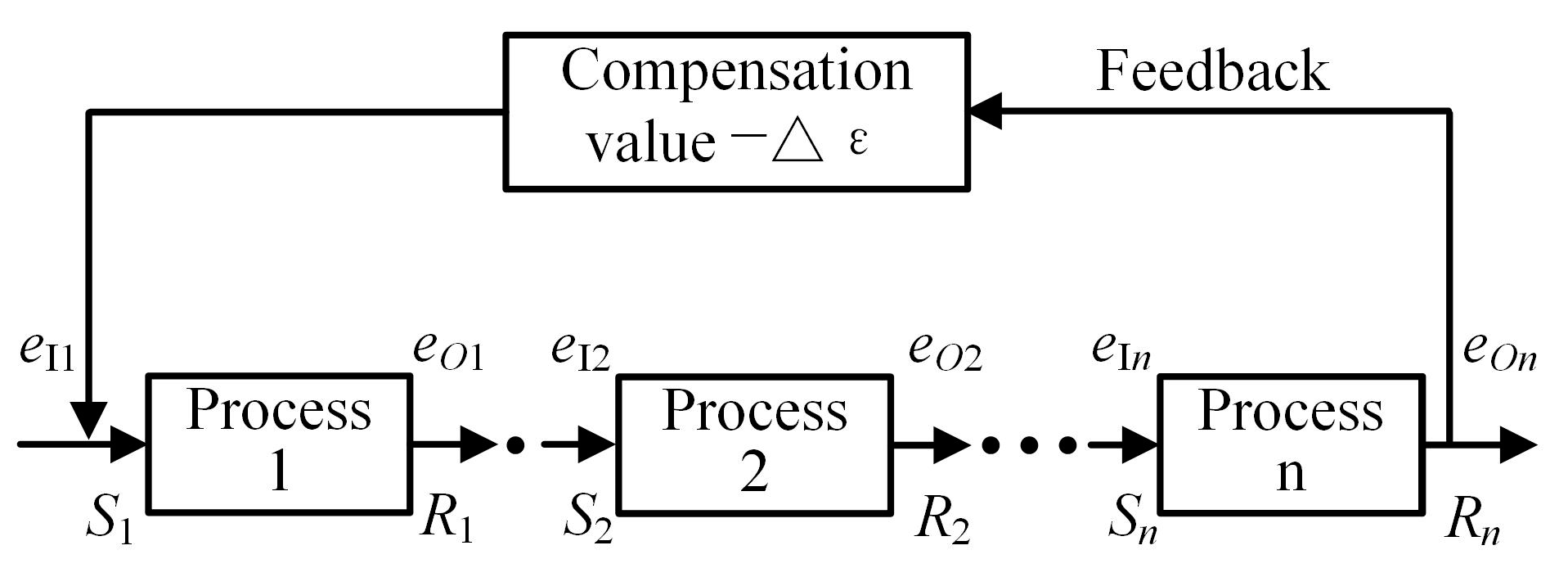

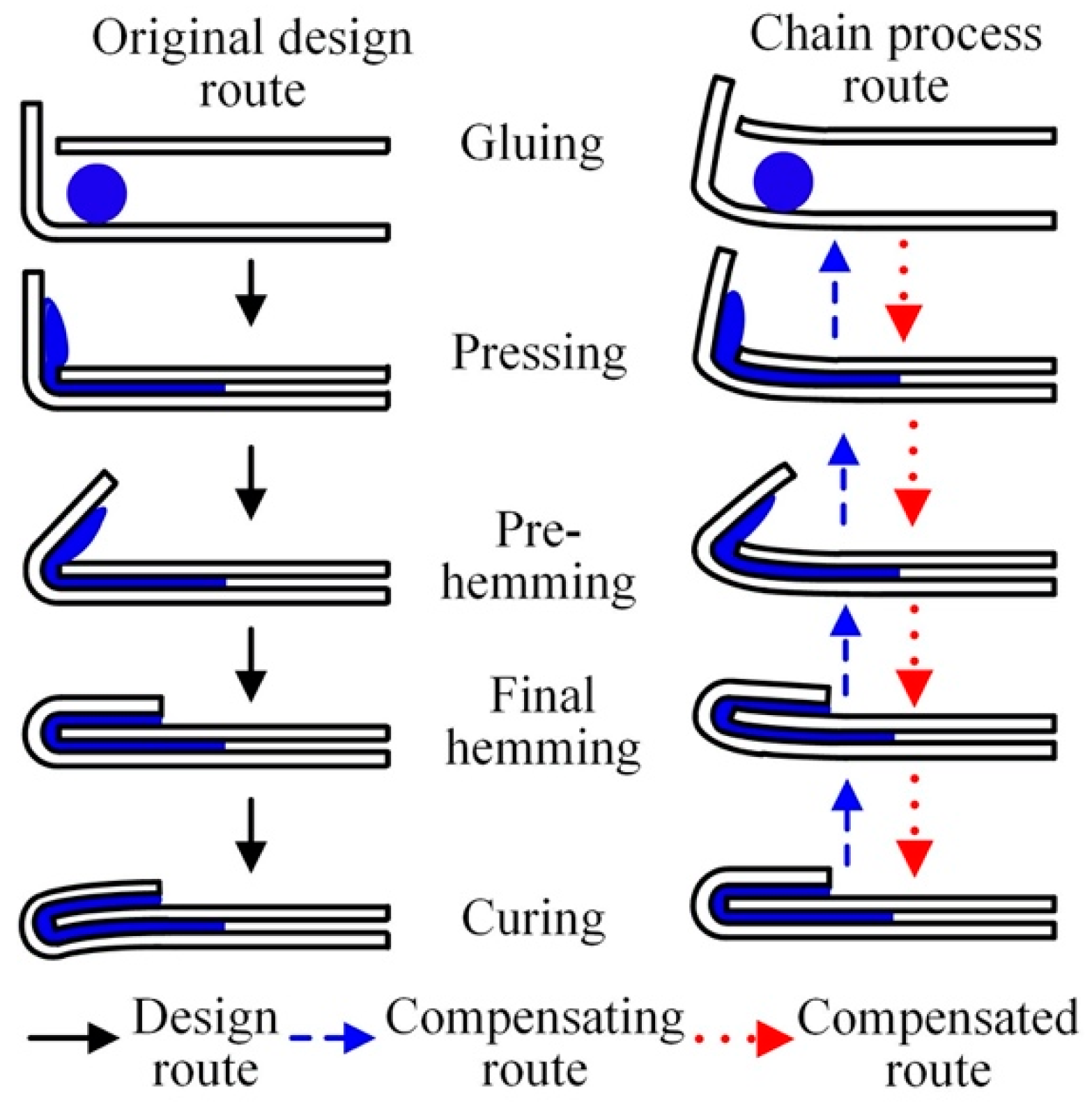
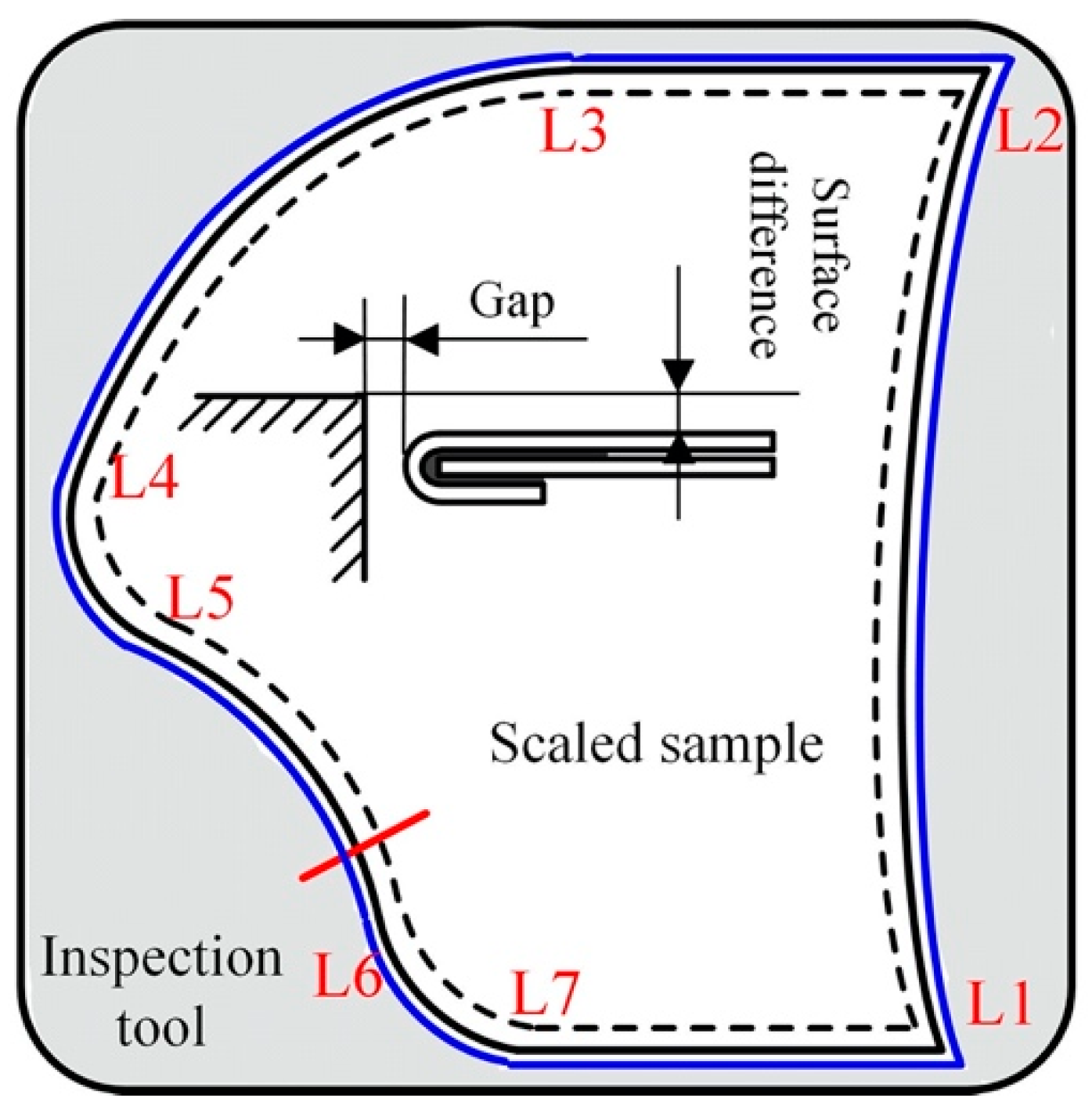
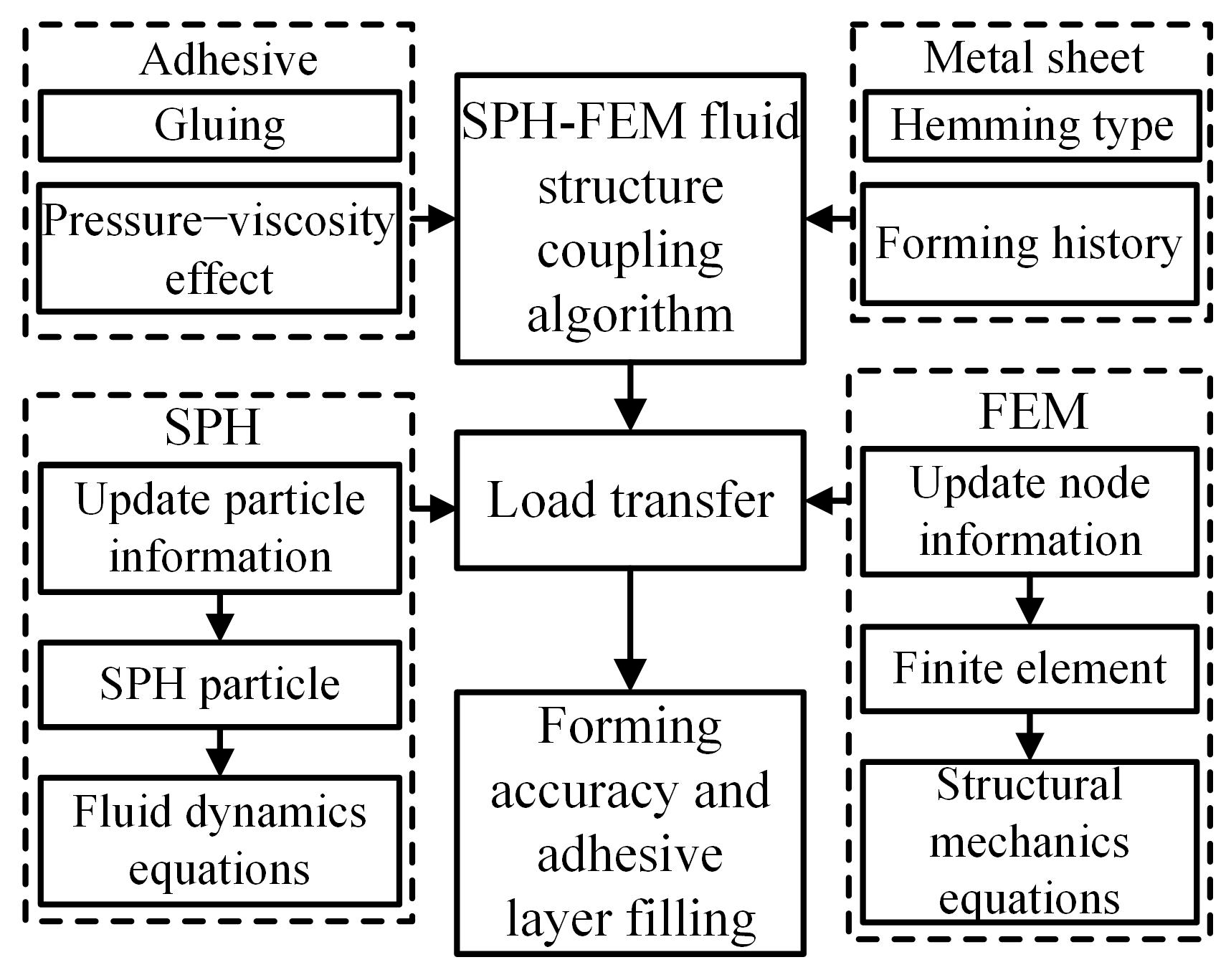
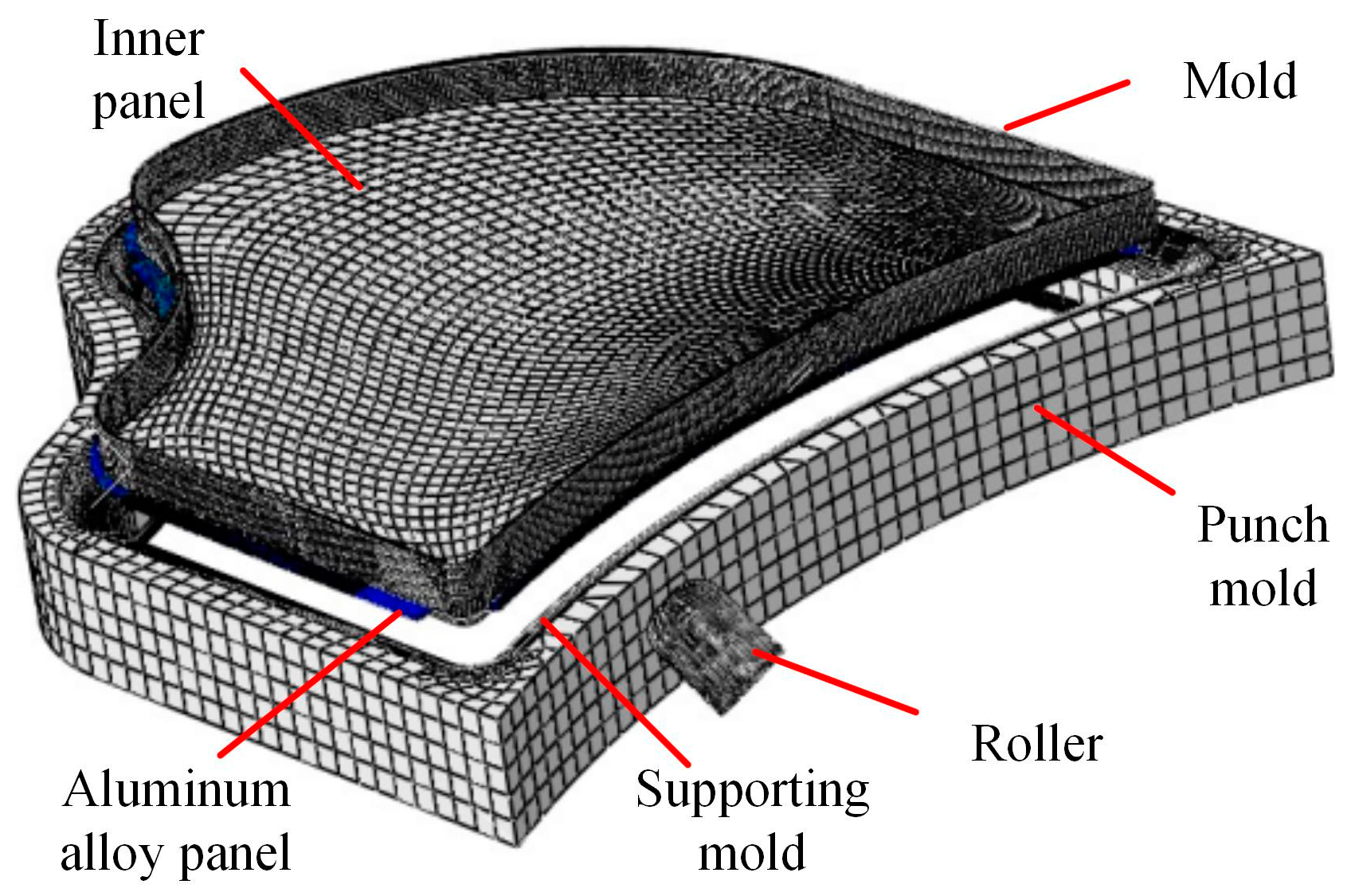

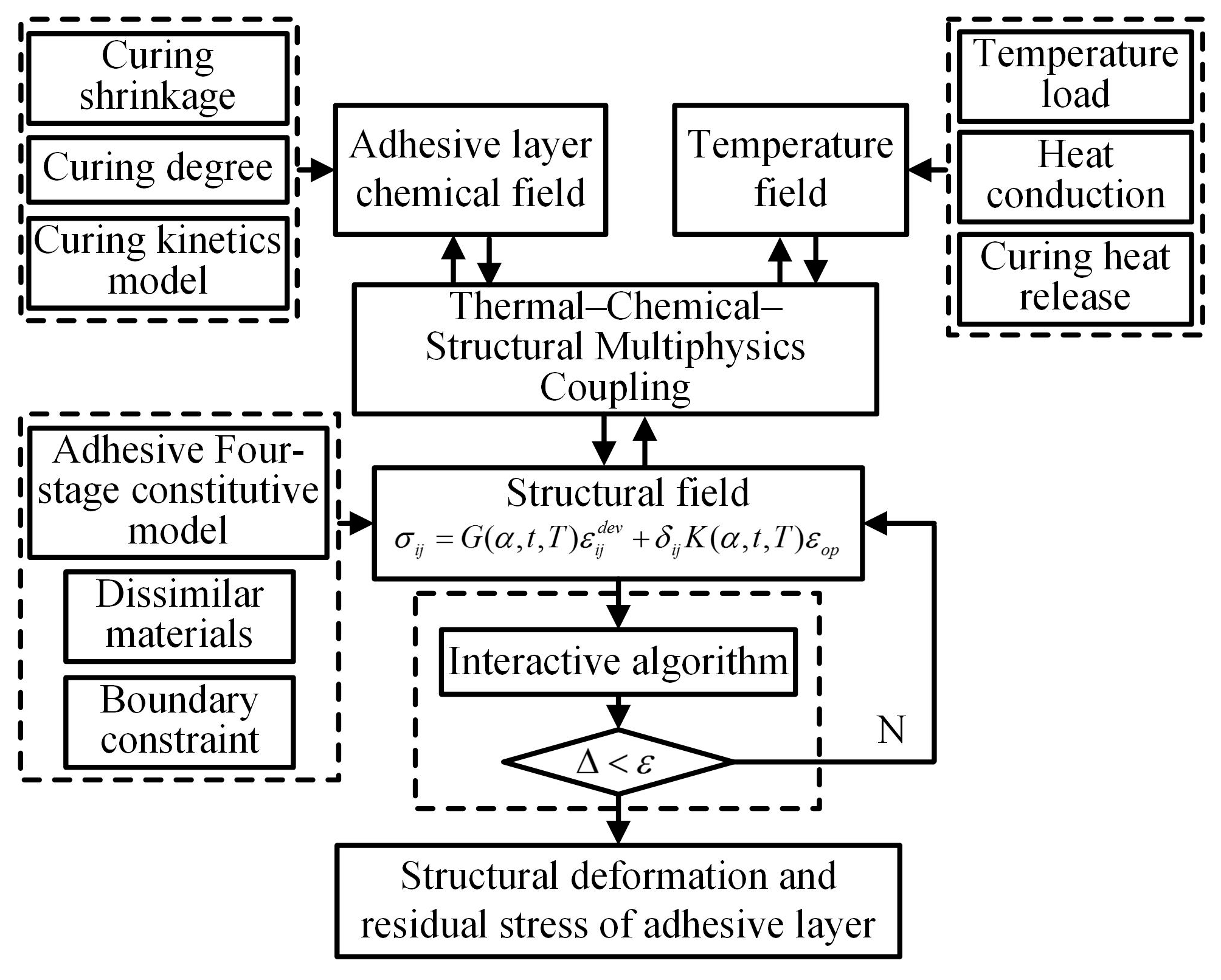
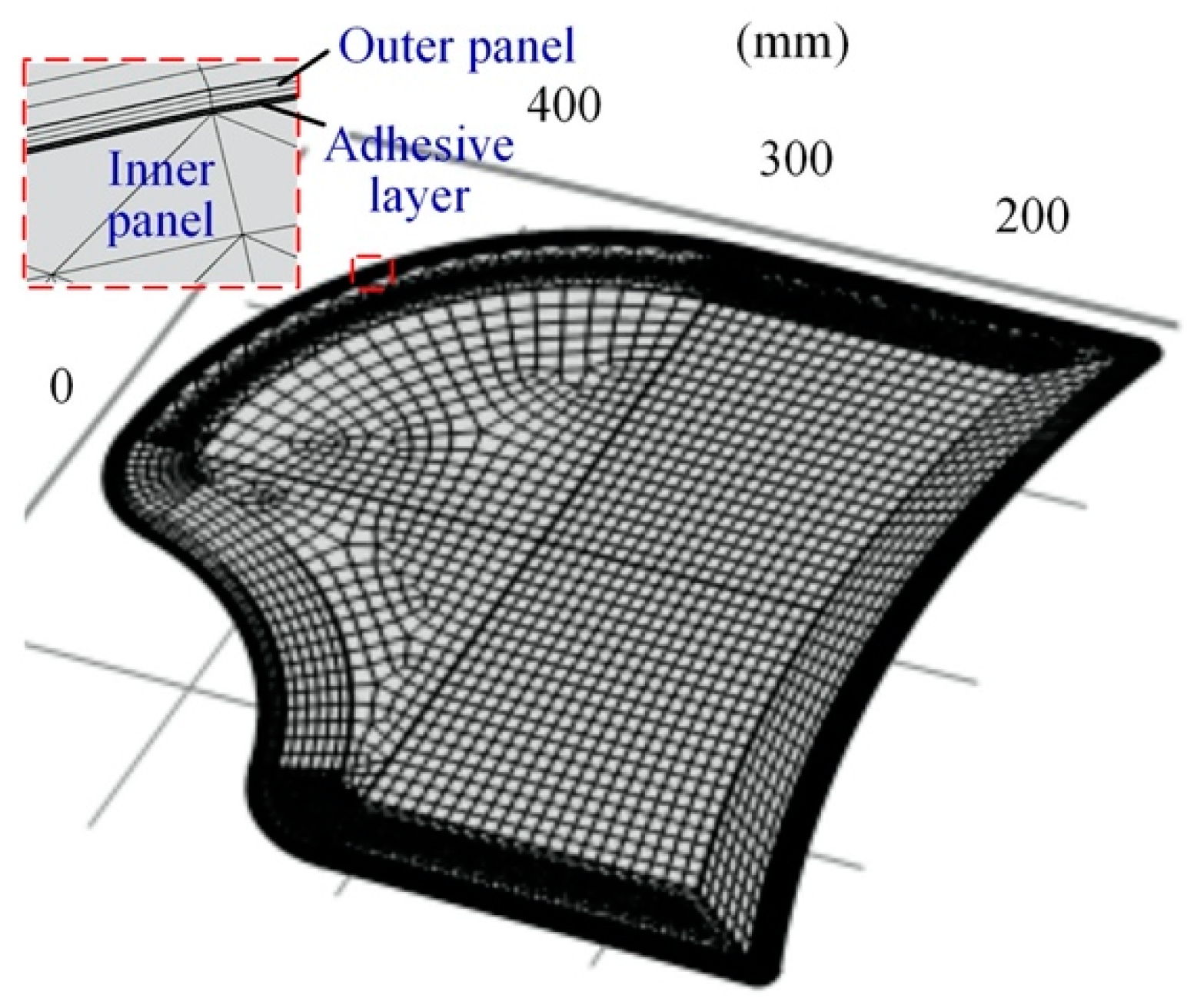

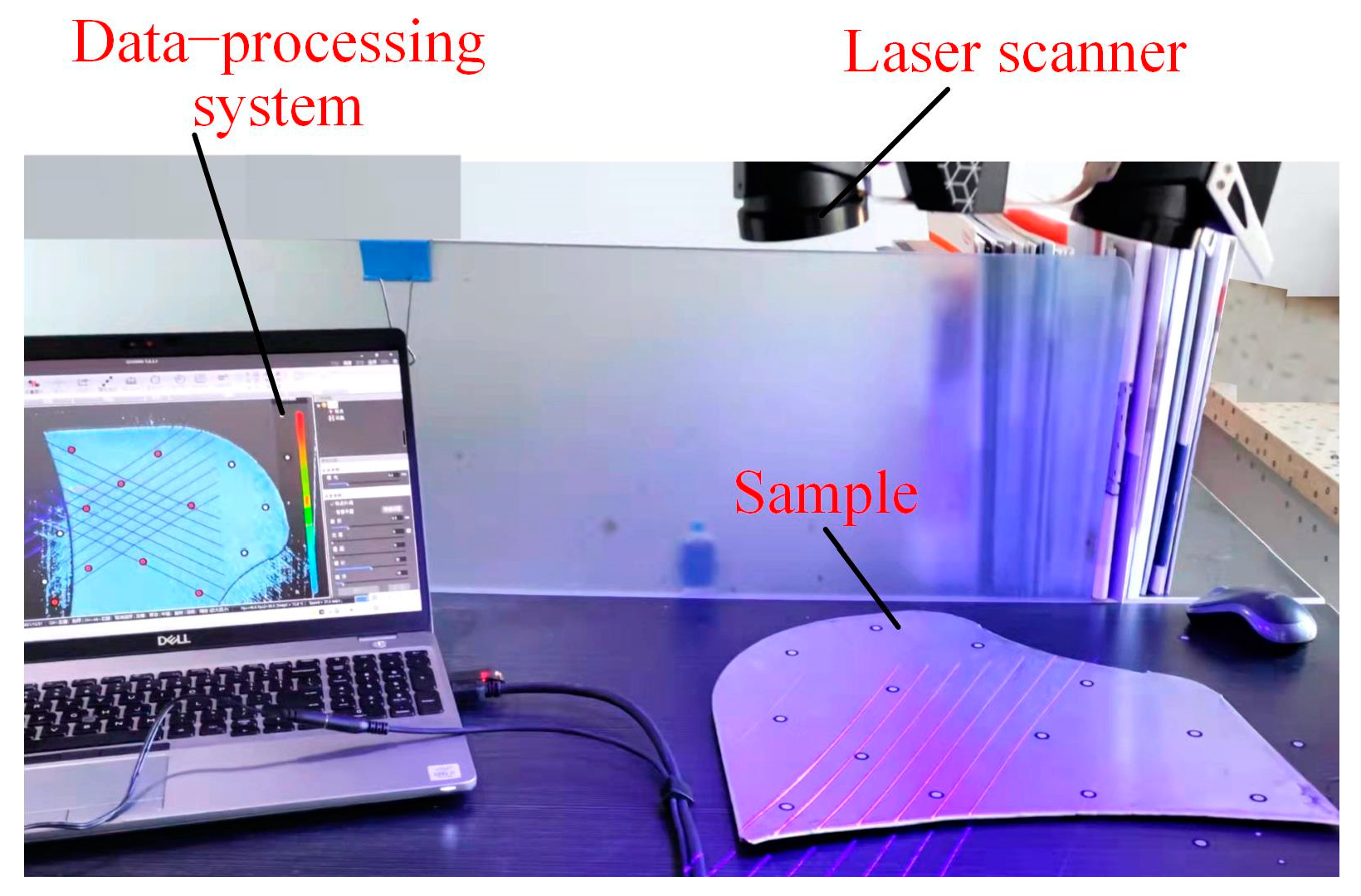
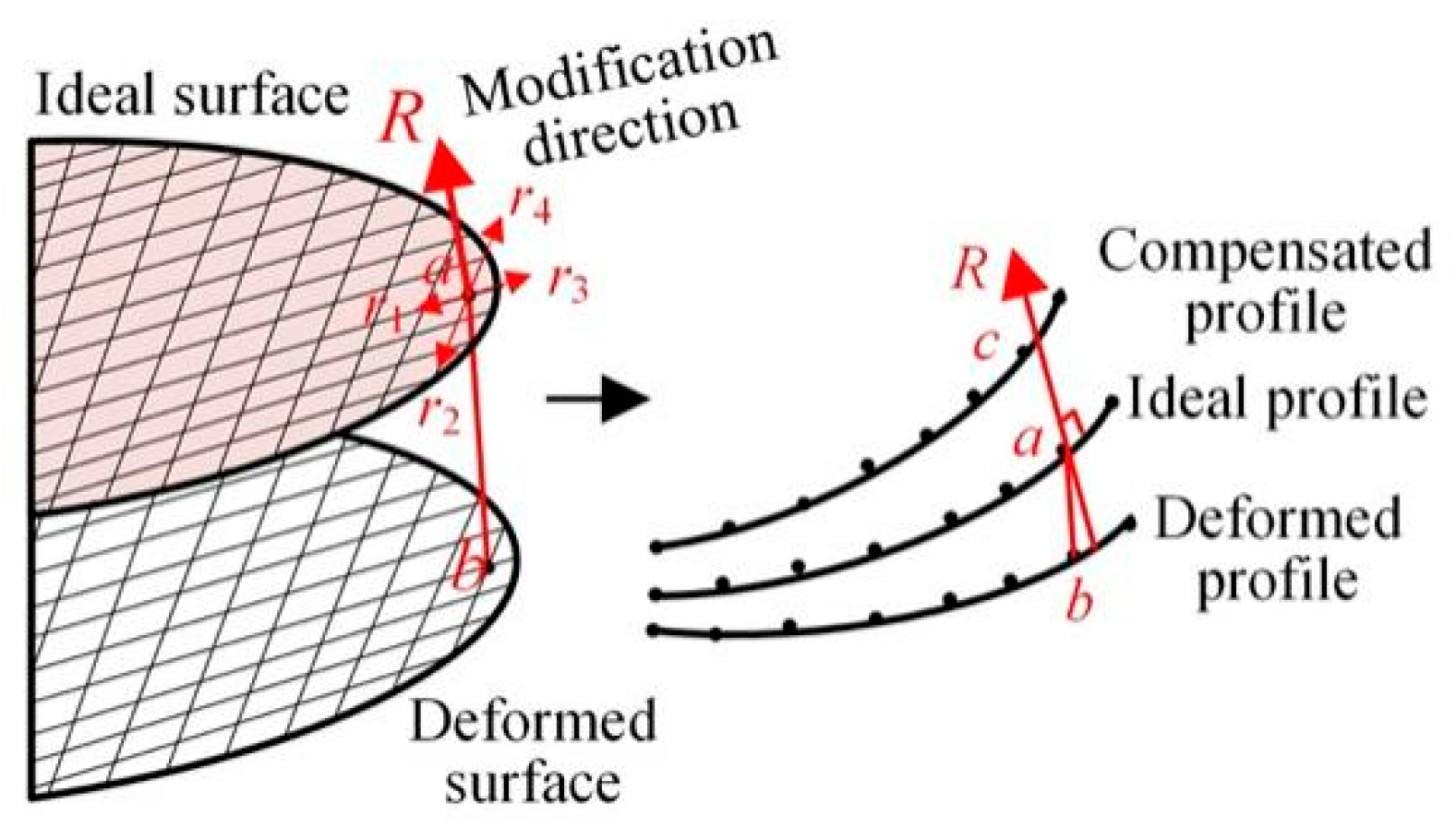



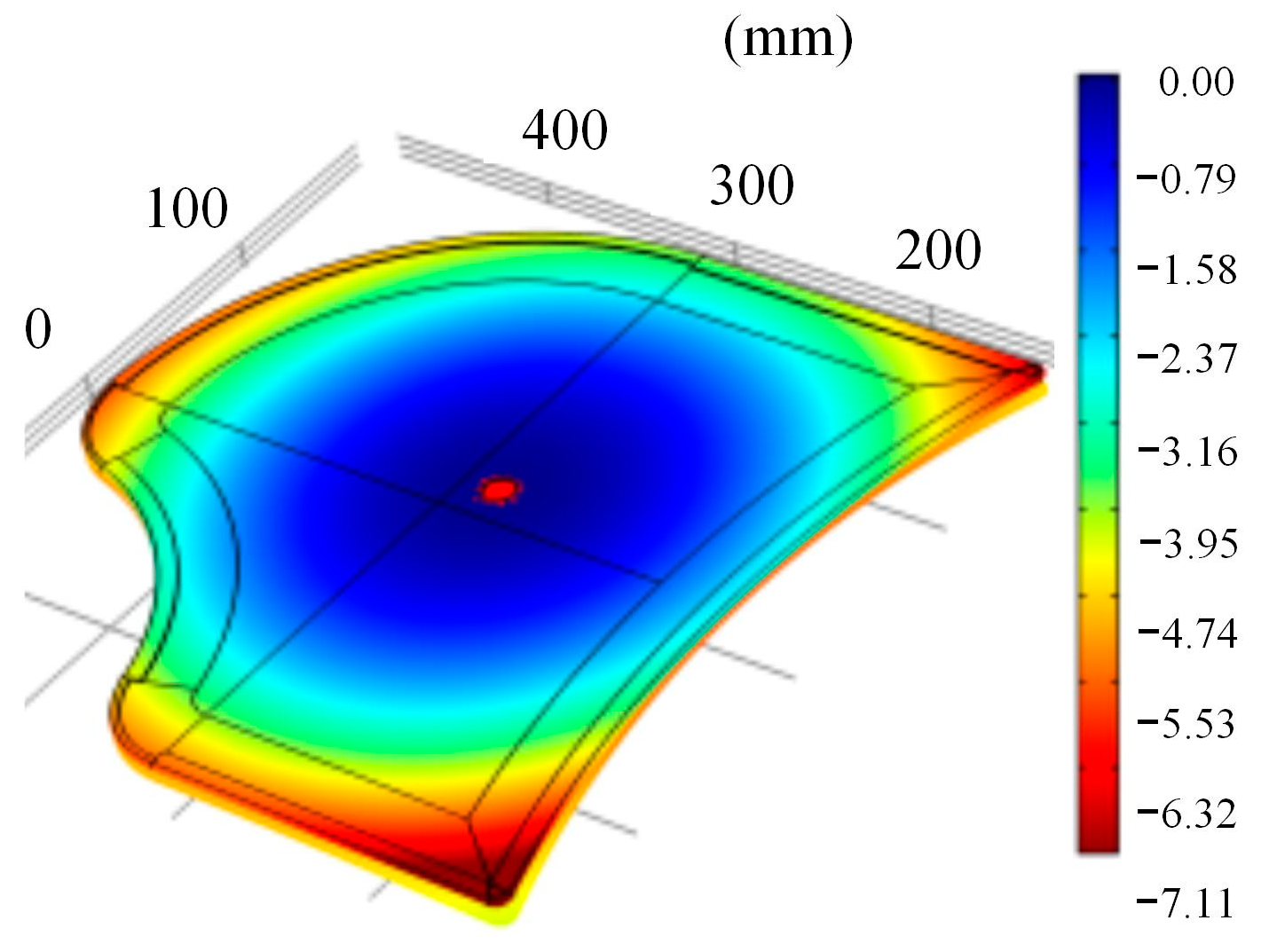
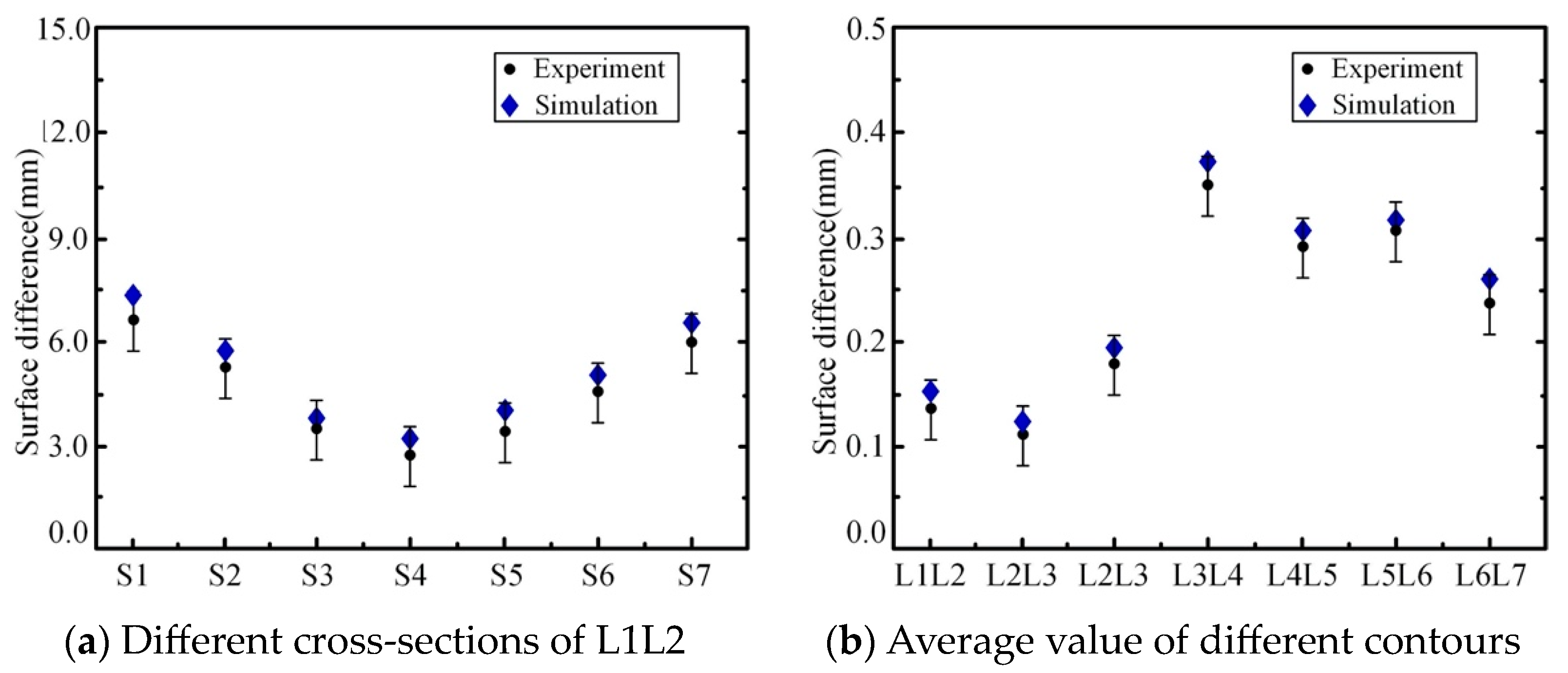
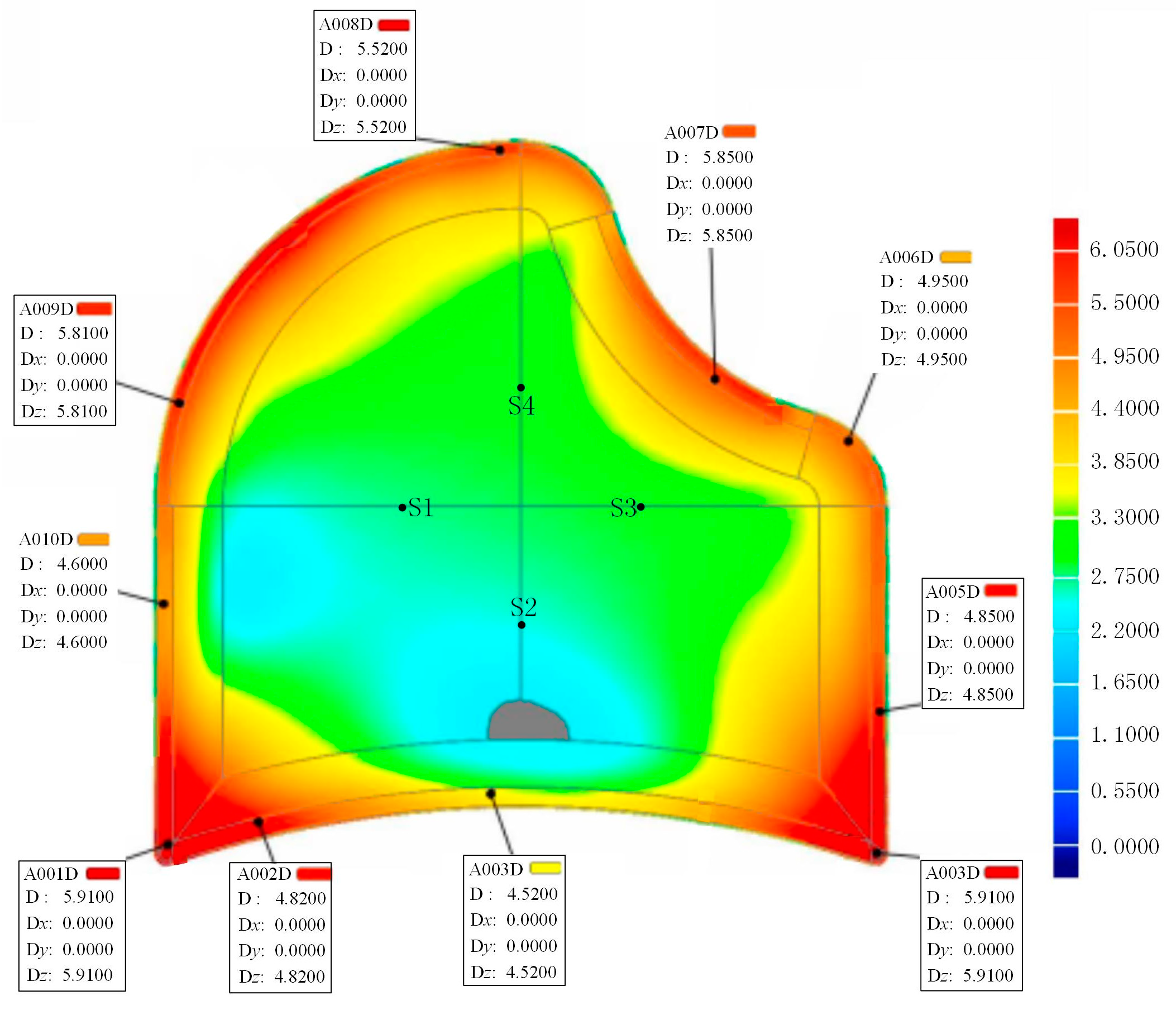
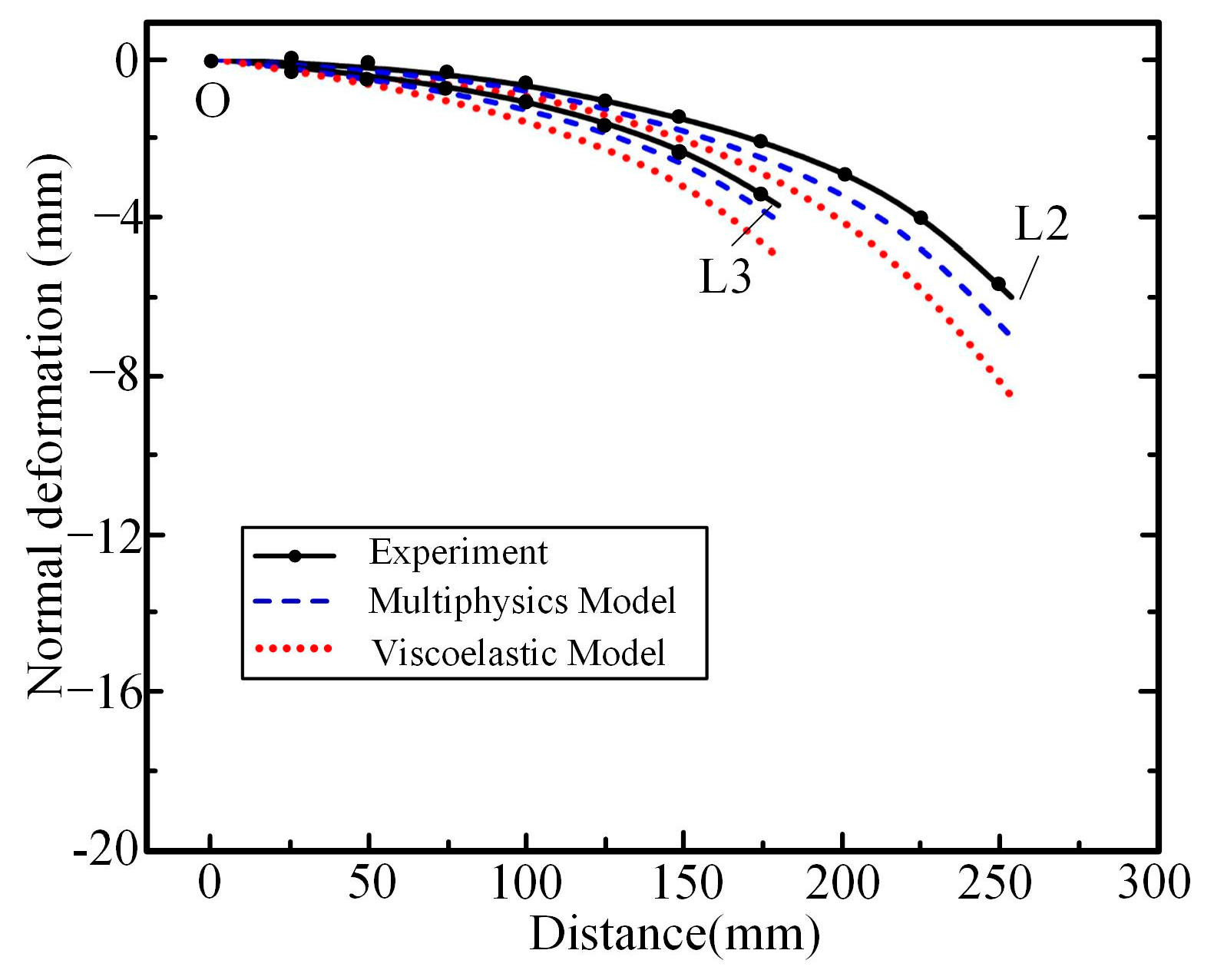



| Segment | L1L2 | L2L3 | L3L4 | L4L5 | L5L6 | L6L7 | L7L1 |
|---|---|---|---|---|---|---|---|
| Contour type | Concave | Straight | Convex | Convex | Concave | Convex | Straight |
| Inner plate radius R1 | 530.0 | — | 180.0 | 50.0 | 136.8 | 50.0 | — |
| Outer plate radius R2 | 530.0 | — | 180.0 | 50.0 | 136.8 | 50.0 | — |
| Outer panel fillet radius r | 0.6 | 0.6 | 0.6 | 0.6 | 0.6 | 0.6 | 0.6 |
| Flanging height H | 8.5 | 8.0 | 6.0 | 4.5 | 5.0 | 4.5 | 6.0 |
| Adhesive edge distance L | 2 | 2 | 2 | 2 | 2 | 2 | 2 |
| Adhesive diameter D | 3.2 | 3.2 | 3.2 | 3.2 | 3.2 | 3.2 | 3.2 |
| Material. Name | Specific Heat (J/Kg·K) | Coefficient of Thermal Expansion (10−6/K) | Shear Modulus (GPa) | Bulk Modulus (GPa) | Thermal Conductivity Coefficient (W/m·K) |
|---|---|---|---|---|---|
| AA6016-T4 | 896 | 23.2 | 26.5 | 57.5 | 167 |
| DC04 | 509 | 12.5 | 80.7 | 175 | 50.2 |
Disclaimer/Publisher’s Note: The statements, opinions and data contained in all publications are solely those of the individual author(s) and contributor(s) and not of MDPI and/or the editor(s). MDPI and/or the editor(s) disclaim responsibility for any injury to people or property resulting from any ideas, methods, instructions or products referred to in the content. |
© 2024 by the authors. Licensee MDPI, Basel, Switzerland. This article is an open access article distributed under the terms and conditions of the Creative Commons Attribution (CC BY) license (https://creativecommons.org/licenses/by/4.0/).
Share and Cite
Li, J.; Sun, Q.; Jia, J.; Zhu, W. Research on Pre-Compensation and Shape-Control Optimization of Hemming Structures with Dissimilar Materials Based on Forming Process Chain. Metals 2024, 14, 1063. https://doi.org/10.3390/met14091063
Li J, Sun Q, Jia J, Zhu W. Research on Pre-Compensation and Shape-Control Optimization of Hemming Structures with Dissimilar Materials Based on Forming Process Chain. Metals. 2024; 14(9):1063. https://doi.org/10.3390/met14091063
Chicago/Turabian StyleLi, Jianjun, Qin Sun, Jia Jia, and Wenfeng Zhu. 2024. "Research on Pre-Compensation and Shape-Control Optimization of Hemming Structures with Dissimilar Materials Based on Forming Process Chain" Metals 14, no. 9: 1063. https://doi.org/10.3390/met14091063
APA StyleLi, J., Sun, Q., Jia, J., & Zhu, W. (2024). Research on Pre-Compensation and Shape-Control Optimization of Hemming Structures with Dissimilar Materials Based on Forming Process Chain. Metals, 14(9), 1063. https://doi.org/10.3390/met14091063





